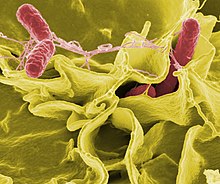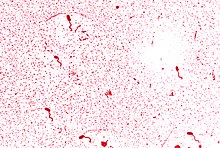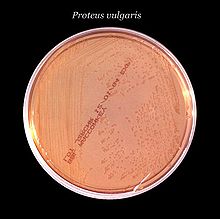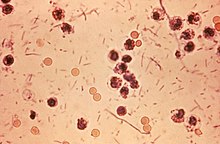Bacteria are said to be the microscopic ones and are also single cell microbes that are seen in many forms being many in nature.
Bacteria can be of two- either the capsulated or non capsulated bacteria. The non capsulated bacteria ones are the ones that tend to have no capsule. Any capsule is said to be an exterior covering that protects the bacteria being it gram positive or gram negative tending to be dangeruos.
The capsules tend to prevent phagocytosis and also desiccation. The bacteria that do not have a capsule or are non capsulated bacteria are the Corynebacterium, salmonella, the vibrio, Neisseria, proteus, shigella and the Pseudonomas. Some of the bacteria be it non capsulated bacteria or the capsulated one can be dangerous while some also tend to be sued in many ways. They might get in support of the life forms for both animals and plants.
They are said to be every first organism in the Earth which implies there stay about from 4 billion years ago. The oldest of the organism that have its fossils are the organism that appear like the bacteria. They can be either organic or even inorganic and this is based on its usage in the food with having the capacity to love in harsh conditions. They are neither said to be any animal or plant with having millions of its form in nature.
The length of the non capsulated bacteria are mostly in micrometers in size and shall be alive all together in millions of communities. Any gram of soil shall have millions of cell of the non capsulated bacteria and the normal bacteria with also only a drop of water containing one million of the bacterial cells. One of the ways to have the capsulated and non capsulated bacteria classified are by its shape. They can be-

Rod shaped
They are called to be the bacillus and some of the non capsulated bacteria that are these tend to also curve. They are then known to be vibrio. An example of this type of non capsulated bacteria can be anthrax. They dwell in the same place and also are solitary microbes and links with the palisades. It refers to a specific general of the non capsulated bacteria.
Sphere shaped
The non capsulated bacteria that tend to be shaped like a ball are called the cocci and also a single one of this type is called the coccus. An example of it can be the strep throat. They have many general and grow in pairs, cluster, chain and is based on its orientated that they get attached during the cell division. They can be either gram positive or negative.
Spiral shaped
They are named to be the spiralla. The non capsulated bacteria have tight coils and are called to be the spirochetes. They are quote of few of the condition that shall be caused by these types. These also tend to be non capsulated bacteria and also are same morphology with varying in size. They are said to be 3rd in terms of its morphology.
Corynebacterium
They are the non capsulated bacteria that are aerobic in most cases and are also gram positive ones and are rod shaped.
They are in much ways seen in nature and in the microbiota of the animals with mostly being innocuous and are also in the form of commensal bond with the host. They tend to be the common existed of non capsulated bacteria. They are also non-pathogenic and do have access to the tissues.
They were first seen by Lehmann in 1896 and these are obligated for causing the diphtheria. The comparative analysis of these non capsulated bacteria have led to the discovery of many unique genera of this non capsulated bacteria type. The principal of this are seen in 1986 and are said to be the non-motile ones, along with being a bit curved or straight, are non-spore making an also positive for catalase. It has a distinctive cell wall and grow slow on the media. They tend to need biotin to grow and this strands also need thymine and PABA.

Salmonella
They are the common non capsulated bacteria and also tend to cause many condition affecting the intestine and the tract in animals and human.
They are seen in both plants and animals and mostly in the intestine with coming out of the body via feces. The humans tend to be infected in many cases via having the food or the water contaminated. The problem caused by this non capsulated bacteria has no symptoms. They cramp in 72 hours.
A good remedy for these are having checked. This can enter the body while some tend to consume bad cooked meat or food with beiges or dairy product, the time for incubation can be for few hours to days. Most of these non capsulated bacteria can be of the stomach fly type and the possible symptoms can be fever, bad cramps, vomit, nausea. It can also cause thphoid.

Salmonella species are intracellular pathogens of which certain serotypes cause illness. Most problems are due to ingestion of food contaminated by animal feces, or by human feces, such as by a food-service worker at a commercial eatery. Salmonella serotypes can be divided into two main groups—typhoidal and nontyphoidal. Nontyphoidal serotypes are zoonotic and can be transferred from animal-to-human and from human-to-human. They usually invade only the gastrointestinal tract and cause salmonellosis, the symptoms of which can be resolved without antibiotics.
Vibrio
They belong to the non capsulated bacteria and are the common sapped ones with from the family of Vibrionaceae.
They are aquatic and some of these non capsulated bacteria can cause dangerous trouble in the animals or humans. They are said to be the ram negative one and are also much motile, do not need oxygen and thus said to be the factitive having flagella for movement on one of its end.

These cells of thesenon capsulated bacteria are curbed and shall be long of about 1 to 3 micron and have spiral in S shape. Some of the common species of non capsulated bacteria Vibrio are the cholera, the vulnificus and the parahaemolyticus. Some of these type can be seen in the eels that are not good and also rest of the fishes. They may cause food related affect and related to many agents like that of the viruses, the parasites and the bacteria. The agents of these can surge to very prions and then range from reproductive.
Several species of Vibrio are pathogens. Most afected-causing strains are associated with gastroenteritis, but can also infect open wounds and cause sepsis. They can be carried by numerous marine animals, such as crabs or prawns, and have been known to cause fatal problems in humans during exposure. Risk of clinical complication and death increases with certain factors, such as uncontrolled diabetes, elevated iron levels (cirrhosis, sickle cell affect, hemochromatosis), and cancer or other immunocompromised states
Neisseria
They are from a large genus of bacteria that shall be colonizing the mucus area of the animals. There are about 11 of these.
Out of these types, there are its 2 types that are common called the gonorrhoeae and the meningitides. They are the gram negative ones and also are grown in the neutrophils. It tends to culture in the supplementation and also is enriched by antibiotics.
It can be an problem of the gentiles, eye and throat along with being common in both males and females. Not getting a check up of it shall be of much hazard. On its surface this non capsulated bacteria has pores or hair like frames called pili and have proteins and sugar called as lipooligosaccharides. Pili is responsible for adhering and also exhibits the variation. Porins and opa proteins are seen in the pili of this non capsulated bacteria that penetrates the mucus level.

Proteus
They are the gram negative ones and shall be called for its ability to be robust across the surface in having a pattern like bull’s eye.
This is an organism that is much frequent with being a pathogen in the urine tract and in particular to many people goes for a long term. It is a motile bacterium that is facilitated by the flagella and has a regulation process being complex and helps itself by swimming.

This is anon capsulated bacteria seen in colonies and includes the making of stone, urease, in the urine tract along with also making of the fimbriae and many adhesions, acquisition of zinc and iron making of biofilm and also many toxins. It yet has challenges to combat in a complicated word by having UTI deciphered. It is also a good non capsulated bacteria for lab works. On the species level, indole is considered reliable, as it is positive for P. vulgaris, but negative for P. mirabilis.
Proteus species do not usually ferment lactose, but have shown to be capable glucose fermenters depending on the species in a triple sugar iron (TSI) test. Since it belongs to the order Enterobacterales, general characters are applied on this genus. It is oxidase-negative but catalase- and nitrate-positive. Specific tests include positive urease which is the fundamental test to differentiate Proteus from Salmonella and phenylalanine deaminase tests.
Shigella
This bacterium of the non capsulated bacteria type tend to cause problem called the shigellosis and most of the people with it have diarrhea.
The symptoms of it usually begin from the body having stomach cramps, fever, after getting infected of about 7 days. Most of the people tend to recover without having any need to the medicines. It can be good level of contagious and can also get infected with this from stool.
Sign and symptoms of this can be much and also develop in a week. The symptoms of it hall last even for about seven to five days or even longer with however many being contagious seeking to be getting a check up for this. It can take place by having either a direct contact with people, having consuming the food eaten by an infected person or also consuming of the water that has been infected with this.

It also has many risk factors. This is a dangerous non capsulated bacteria and can be bad not only adults but also the children under 5 years. Any close contact with people tending to have it might be useless. This shall outbreak also in places having good risk of developing and also after reproduction matters. Shigella is found in the intestinal tract of infected people, and is spread by eating or drinking food or water contaminated with the bacteria. It can also be spread by direct contact with feces even with microscopic amounts from an infected person.
Pseudomonas
Pseudomonas is a genus of Gram-negative, Gammaproteobacteria, belonging to the family Pseudomonadaceae and containing 191 validly described species.
The antibiotic ciprofloxacin is used extensively to get a wide range of problems caused by the opportunistic pathogen Pseudomonas aeruginosa. Due to its extensive use, the proportion of ciprofloxacin-resistant P. aeruginosa isolates is rapidly increasing. They are thus a good non capsulated bacteria type. Antisera to lipopolysaccharide and outer membrane proteins show cross-reactivity among servers.
Pseudomonas aeruginosa and P maltophilia account for 80 percent of opportunistic problems by pseudomonads. Pseudomonas aeruginosa problem is a serious problem in patients hospitalized with cancer, cystic fibrosis, and burns; the case fatality is 50 percent. Other problem is caused by Pseudomonas species include endocarditis, pneumonia, and problems of the urinary tract, central nervous system, wounds, eyes, ears, skin, and musculoskeletal system. Phagocytosis by polymorphonuclear leukocytes is important in resistance to Pseudomonas problems.

Antibodies to somatic antigens and exotoxins also contribute to recovery. Neutropenia in cancer patients and others receiving immunosuppressive drugs contributes to problem. Pseudomonas aeruginosa has several virulence factors, but their roles in pathogenesis are unclear. An alginate is antiphagocytic, and most strains isolated produce toxin A, a diphtheria-toxin-like exotoxin. All strains have endotoxin, which is a major virulence factor in bacteremia and septic attack. Motility is by a single polar flagellum. Species are distinguished by biochemical and DNA hybridization tests.
Also Read:
- Is enzyme a catalyst
- Is a chromosome an allele
- Do chromosomes contain protein
- Lactose fermenting bacteria examples
- Hypertonic vs hypotonic
- Glycolipid structure
- Are protists eukaryotic
- Nucleic acid examples
- Are proteins soluble
- Chromosome structure
I am Ankita Chattopadhyay from Kharagpur. I have completed my B. Tech in Biotechnology from Amity University Kolkata. I am a Subject Matter Expert in Biotechnology. I have been keen in writing articles and also interested in Literature with having my writing published in a Biotech website and a book respectively. Along with these, I am also a Hodophile, a Cinephile and a foodie.
